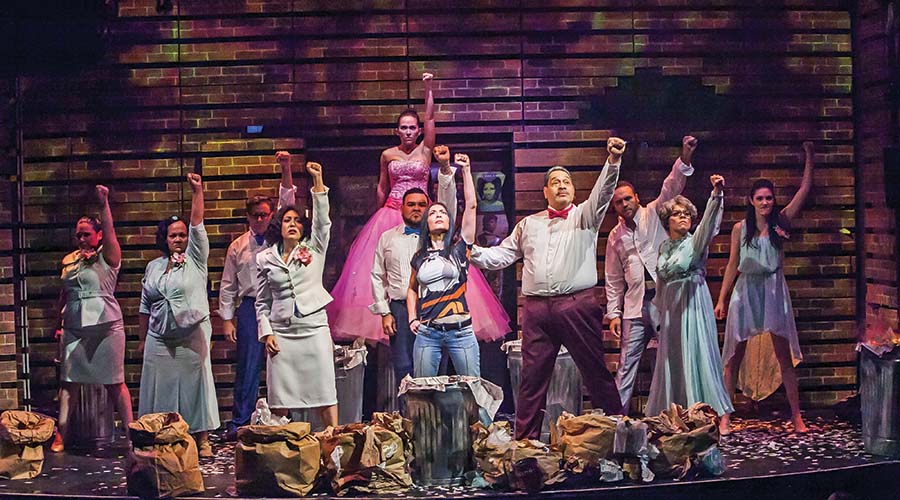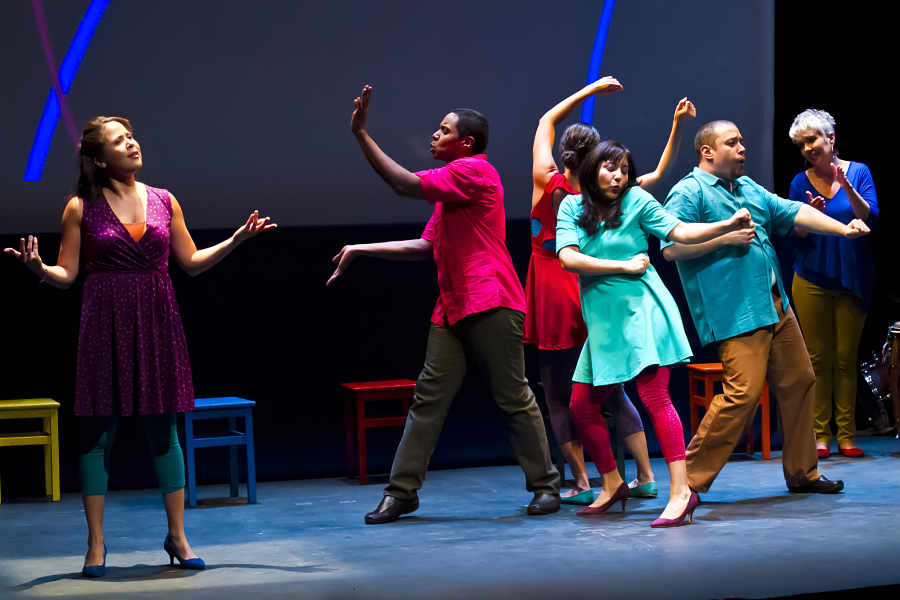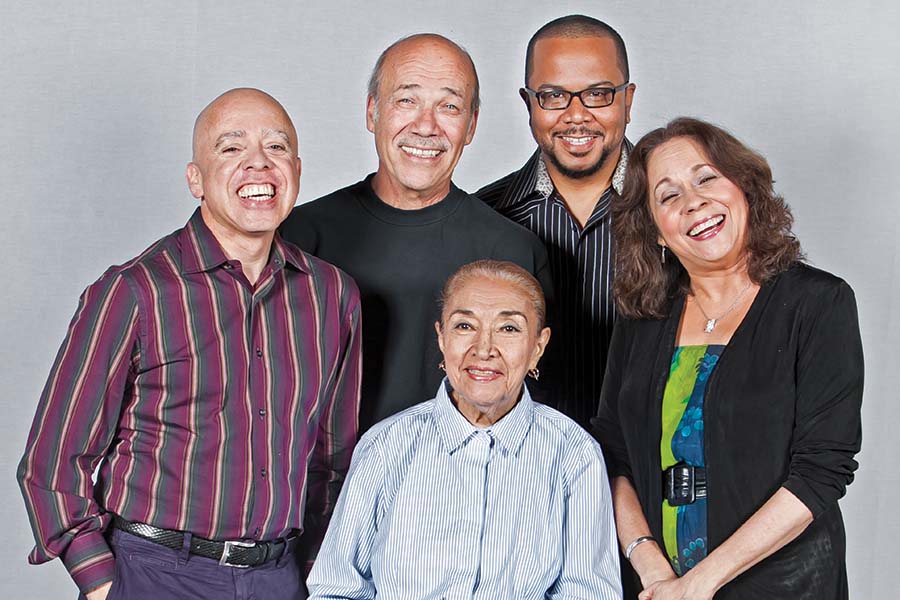A few swift steps off 8th Avenue on West 47th Street in New York City take you to the Puerto Rican Traveling Theatre (PRTT). The facade is fire engine red but otherwise unobtrusive. Squeeze through the double doors, and in only a few more paces you enter the 190-seat space.
Every one of those seats seemed filled for a Tuesday-night performance of I Like It Like That in late September. This season-opening musical by David Maldonado and Waddys Jáquez, starring Tito Nieves, is full of classic salsa tunes made famous by the likes of Rubén Blades and La Lupe, taking New York audiences back to “El Barrio—The ’70s—When Salsa was the Religion of the Masses,” as the tagline reads. Intimate digs for a salsa musical, I mused, eyeing the narrow proscenium.
The intimacy was obvious once the show was underway, and not only due to the venue’s size. In one scene, a Puerto Rican godmother (a hilarious Rossmery Almonte) gushes over her godchild Paula’s quinceañera dress, discussing the food she has prepared for the party: “I bought you a wonderful cake—”
“At Valencia!” a good percentage of the audience cried in response before Almonte named the bakery. A Google search later revealed to me that Valencia Bakery, still located on 499 East 138th Street in the Bronx after 60 years, specializes in birthday cakes. Many attending I Like It Like That clearly did not need Google to tell them that.
The house was buzzing, fueled by more than the thumping salsa beat and the energetic performances. I felt the invigorating sensation of recalling something so familiar it makes you grin before you even recognize it. As a millennial Venezuelan raised in Fort Lauderdale, Fla., and Caracas, I did not think I would find anything to be nostalgic about in a 1970s Puerto Rican NYC barrio. Little did I know!
More answers awaited me in the Bronx. Pregones occupies a snug 130-seat space carved out of a 9,000-square-foot former warehouse on Walton Avenue. I particularly admired the striped audience chairs, arranged in such tidy rows that I was surprised when an ensemble member plucked one from the front row to join me for our chat on the stage floor.
Pregones members obviously adore their home, unveiled in 2005, and built with funds raised in a $2.7 million capital campaign. Before our interview began, Alvan Colón Lespier and Jorge Merced, both associate artistic directors of Pregones/PRTT, showed me works of Puerto Rican art on exhibit in the lobby, including a beautiful mosaic mural by Manny Vega featuring Oshun, a Yoruba goddess, swimming in a blue sea. It was like art displayed in someone’s living room, and the company has indeed often called the Walton venue Pregones’s casa propia, their own home. But when you’ve worked so hard to create a home that is yours, can you let others in? Do you dare venture out?
Pregones and PRTT, two prominent Puerto Rican theatre companies, decided to cross their thresholds in tandem, beginning a merger in 2013 and fusing names, venues, and missions to form a new single entity, helmed by Rosalba Rolón, cofounder of Pregones and artistic director of the merged group, and Miriam Colón, founder of PRTT and current senior artistic advisor. But while Pregones and PRTT have pooled resources and artists, Rolón explained, they “didn’t want to just merge the identities of the theatres, but rather respect and honor what each stands for.” Soldanela Rivera, an artist on the board of the merged company, described it metaphorically: “The organization began with puertorriqueños. We have two lands—now this theatre has two lands, one uptown, one downtown. We live here, and we have a home there, and our heart is wherever we are.”
A look at each troupe’s roots explains why they mesh so well. PRTT’s Colón—a trailblazer who changed the course of American theatre over a 60-plus-year career—caught the theatre bug from a grade-school play in her native Puerto Rico, and later attended the University of Puerto Rico’s drama program.
Colón’s travels soon took her to New York, as the first Puerto Rican drama student to receive a scholarship to study at the Dramatic Workshop and Technical Institute, and the first Puerto Rican accepted as a member of the legendary Actors Studio. It was after performing in the first English-language production of René Marqués’s groundbreaking play La carreta/The Oxcart that Colón recalled how, as a student in Puerto Rico, she had been part of a traveling theatre, bringing art to sleepy towns. Colón soon started a program, sponsored by then-Mayor John Lindsay, that toured La carreta to several neighborhoods in free bilingual performances—a summer program that eventually grew into the Puerto Rican Traveling Theatre, founded in 1967.
Pregones began in 1979 with a similar traveling-theatre model, and Colón immediately saw the affinity. “I’ve known [Pregones] for many years, and I’ve seen them emerge, and how they were courageous,” said Colón.
“We both built our history from the touring perspective,” Rolón explained. But Pregones didn’t want to remain itinerant, deciding after a nomadic series of residencies and “runouts” to move into a church gym, then a performance studio, before they discovered the Walton Avenue warehouse.
But it would be a mistake to think of Pregones as a new-model PRTT, or simply a satellite theatre uptown. Honoring the companies’ distinct legacies is key to understanding why the Bronx venue remains so important to Pregones. Though proud of their shoestring origins and roving tradition, the company knew that putting down roots in their own space was essential to take their work to the next level. Original Pregones members are emphatic that the Bronx location and audience are just as cultivated, distinct, and vibrant as the midtown location and audience of PRTT.
“We in the Bronx have been so immersed in creating this space, creating the culture and the tradition of people who understand and who become patrons of our organization,” said Merced. “One of the questions in our minds is: How is the world moving, and how do we respond as Latino artists, as Puerto Rican artists? We make sure there is a professional arena for that exploration to take place, and an audience who can see how artists coming from that context are responding to their needs and to their questions too.”

The primary challenge for both companies was how to merge their approaches. While Pregones’s tight-knit ensemble created or adapted most of the works they have staged—hits like El bolero fue mi ruina, Dancing in My Cockroach Killers, Baile Cangrejero, El apagón/The Blackout, and more—PRTT was known for staging classics and new plays, in English and Spanish, from Puerto Rico, Spain, Chile, Mexico, Venezuela, and other Latin American countries, as well as plays by U.S.-based artists. Some classic examples: Ariel Dorfman’s Death and the Maiden, Isaac Chocrón’s O.K., and Pedro Pietri’s The Masses Are Asses.
The merged Pregones/PRTT stages about three mainstage shows per season, each with casts of 4 to 12. The plays are translated into English or Spanish, depending on their origin, with surtitles projected onto the set. The remainder of the season includes guest performances, music series, readings, presentations of works-in-progress (such as Remojo, meaning “soak,” an artist showcase of developing works), educational programs, and community events. The season takes place at both venues, creating what Rolón refers to as the “Bronx-Manhattan Theater Express.” PRTT’s actor training programs are complemented by Pregones’s focus on creating and updating a roster of repertory works and creating a core ensemble team.
New artists joining the company get steeped in the rich history of Puerto Rican and other Latinx theatre traditions, heavily influenced by music, dance, and techniques inspired by the likes of Brecht and Augusto Boal (founder of Theatre of the Oppressed), among others. Company members get to work with visiting Latinx artists, professional actors and/or musicians, plus various other theatre groups, Latinx and otherwise. Working with these other groups, Merced pointed out, means remembering “it’s not about hierarchy, it’s about teamwork.” Positioning people to own their art is the ultimate goal: “We are an ensemble that understands the value of having multiple voices in that chorus.”
Desmar Guevara and Yaremis Félix, two artists who effectively grew up with Pregones, now play large roles in the merged company. Guevara is the musical director and composer of the group, and Félix works in an administrative capacity when not onstage. She recently received a fellowship from the National Association of Latino Arts and Culture Leadership Institute.
“Yaremis is getting an immersion experience in handling a lot of things,” Rolón said with a hearty laugh. Many younger members are acquiring experience working at the office: Shadia Fairuz, who played Tito’s wife in I Like It Like That, is an ensemble member, and, Rolón said, has managed the education program for the past six months.
But the work of Pregones/PRTT is not only relevant to Latinx performers or theatregoers. “The demographics in our city continue to evolve,” Rolón confirmed. “Now you have a family coming in, a Latino and an Asian partner, or a white partner, or a black partner, and their kids are mixed.” The company received a note from an audience member, saying, “‘My Americana girlfriend got it! Thank you!’ He was able to bring in his girlfriend, who is not Latina, and she understood.”
In Pregones’s lauded collaborations with the Appalachian touring company Roadside Theatre and the New Orleans-based African-American company Junebug Productions, communities of artists are often drawn together by parallel, though not identical, experiences of marginalization and ethnic pride.
“It’s all about your neighborhood,” Rolón said, then asked rhetorically: “Is all of our audience from the Bronx? You’d be surprised to know that 55 or 60 percent is from the Bronx. The rest comes from New Jersey, Philadelphia, Brooklyn, Manhattan, Queens, Staten Island, Massachusetts, Yonkers. Who knew?”
Which brings us back to my experience with I Like It Like That. Sure, I listened to the salsa my parents played in the house during my childhood; I could identify with the foibles and endless amusement to be found in a typical Hispanic family. But how would this musical speak to someone who didn’t share this formative experience?
Rolón smiled at my question and quoted Gabriel García Márquez: “‘We inherit the memories of our parents.’ We have many people here who tell us, ‘I haven’t been to Puerto Rico, but I feel as if I have.’” I Like It Like That helps connect those with direct memories of the decades-old events of the play—the unrest, the prominence of the Young Lords Party—with those who may only have heard about them; everyone can find something to enjoy. “The more specific you are, the more universal you can be,” Rolón asserted confidently.

It is not easy for a minority population to own both cultural specificity and claim their place in performance history. Pregones/PRTT is dedicated to reminding everyone that Latinx theatre is a not a niche market, nor is it a simple exercise in maintaining diversity “cred.” Latinx theatre is a vital part of the American theatre, despite receiving little attention in mainstream media outlets.
“We have as Latino artists a lot to contribute to the way that theatre is done in whatever areas of the country we are,” Merced affirmed. “We are who we are, and we have been contributing to the trajectory of the American history for a long time—there’s a lot of us here who have been doing that.”
In 2013, the Theater Subdistrict Council, a not-for-profit corporation, announced it would give $1 million to one theatre company that could develop a “game-changing innovation for the theatre business.” One year later, they chose instead to split the prize, awarding $500,000 to Pregones/PRTT for their Plataforma project (the other $500,000 went to the Public Theater’s Public Works program).
According to Pregones/PRTT’s website, the Plataforma initiative “solicits curatorial ideas…from thinkers and practitioners inside and outside of the arts,” and “contracts Latino artists of merit to work cooperatively with Pregones/PRTT in developing and presenting their original works.” I Like It Like That is a Plataforma joint, and creators Maldonado and Jáquez worked closely with Pregones/PRTT ensemble members to develop and stage it. The Plataforma project was designed to increase the “flow” of work and audiences between uptown and downtown, and is mostly supported by public funds.
Latinx and other minority theatremakers are often at risk of being treated as tokens at larger institutions. All the more reason, Lespier noted, to have a company dedicated to exploring, expanding, and reinventing Latinx works for their own sake, rather than playing into the trend of larger companies “bringing in a Latino director to ‘season up your season.’”
But while there are persistent disparities, Pregones/PRTT doesn’t waste much energy on frustration and outrage—there’s too much else to talk about. “There is always this expectation that if you are a Latino artist, you only talk about Latino things—identity politics,” said Rolón. She noted that in the troupe’s Exchange Project with Roadside and Junebug, the companies chose not to stage a “three-act opera about our coal-miner problems, or the South,” or any other of their collective community concerns. Instead, she said, “We decided to do a play about love.”
On the other hand, it’s not as if Pregones/PRTT is running from its ethnicity, particularly in a national climate in which, as Merced put it, “The mere nature of being a Latino theatre company is so political—it is an act of political affirmation.”
Added Lespier, “It’s us speaking for ourselves—in these times, that’s an act of defiance. Don’t talk for me; I have a voice, I can tell it, I can tell my story!”
Merced spoke movingly of the vision the company had when they set up their home in the Bronx a decade ago.
“When we built this theatre, and this was an abandoned warehouse full of garbage, we said, ‘This is going to be a home for the arts.’ We had the vision to say it was going to happen there. Almost everyone said, ‘You’re crazy’—the way they say that to every artist, especially Latino artists throughout the nation. ‘A theatre there? How?’ Elected officials, they all said the same things. We just celebrated 10 years in the Bronx in this venue, and those same individuals that questioned our crazy vision back then, are the ones that are so proud of the work we do here now, that want to showcase us. And we are not the only ones.”
“At the end of the day, the audience has spoken,” Rolón concluded jovially. “You will hear them tonight, speaking loudly.”
Fabiana Cabral is a writer and editor based in Boston.


